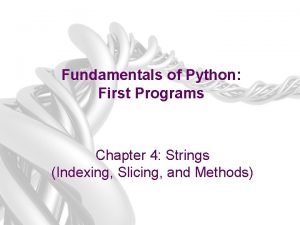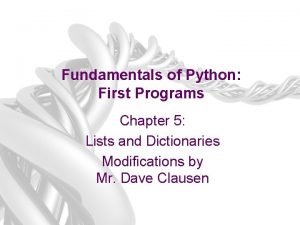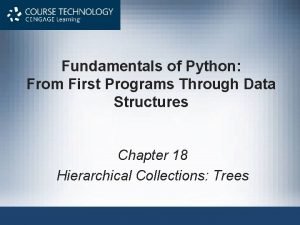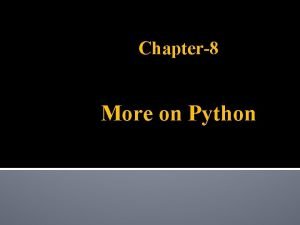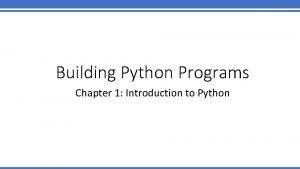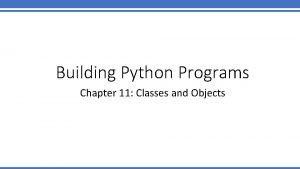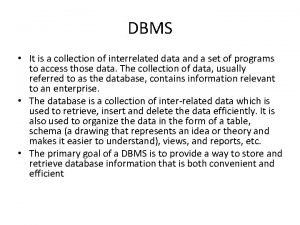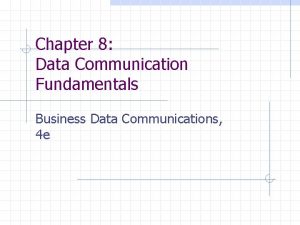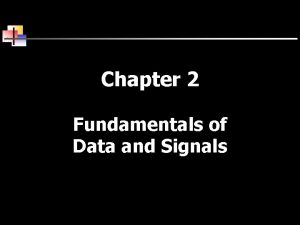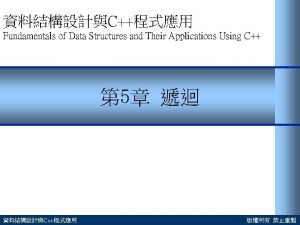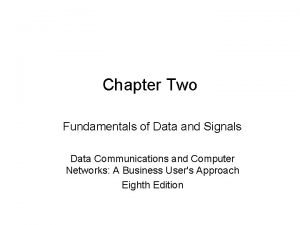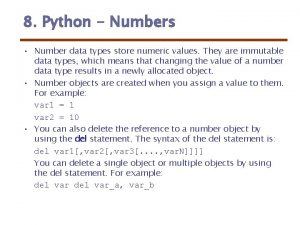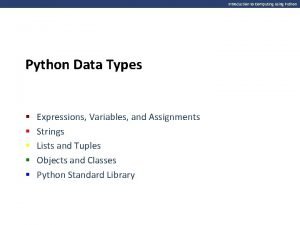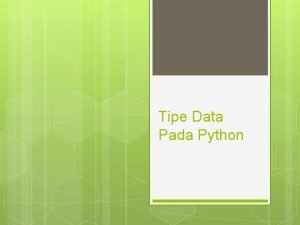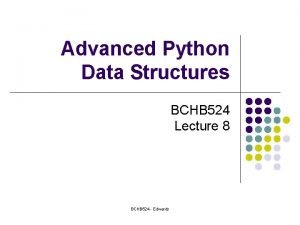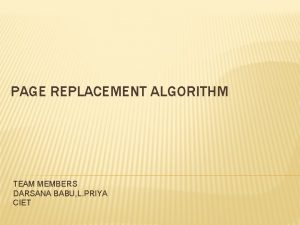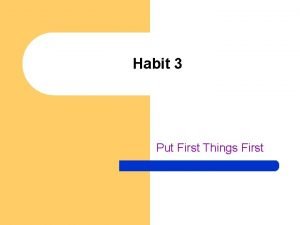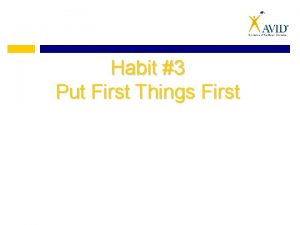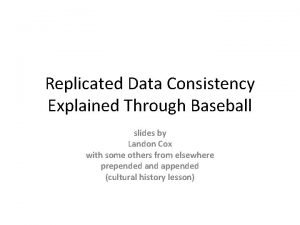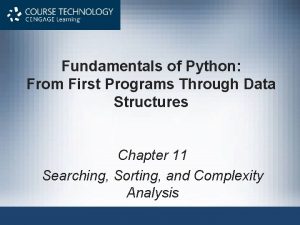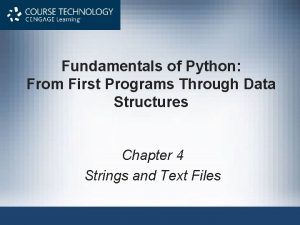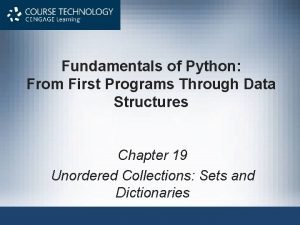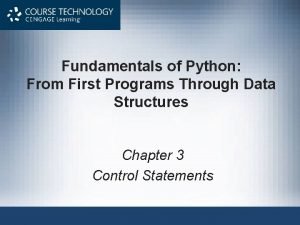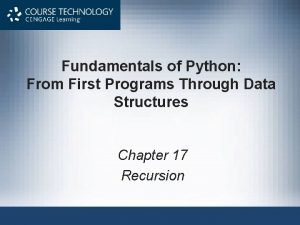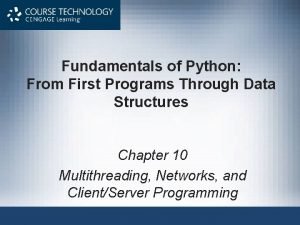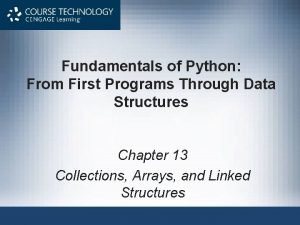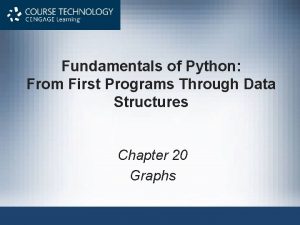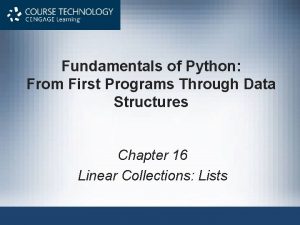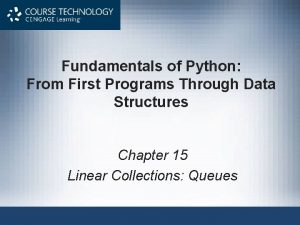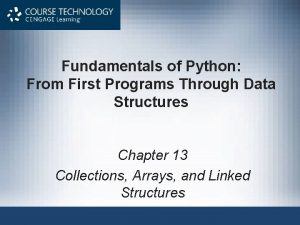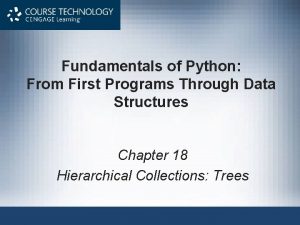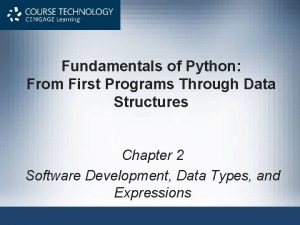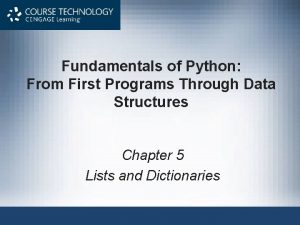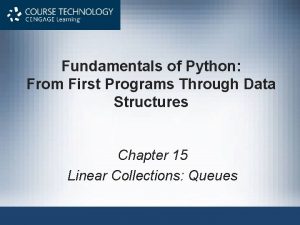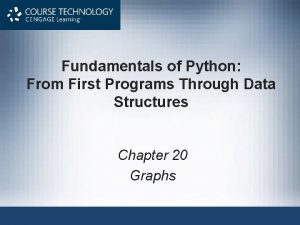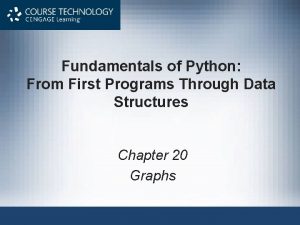Fundamentals of Python From First Programs Through Data





























































- Slides: 61

Fundamentals of Python: From First Programs Through Data Structures Chapter 18 Hierarchical Collections: Trees

Objectives After completing this chapter, you will be able to: • Describe the difference between trees and other types of collections using the relevant terminology • Recognize applications for which general trees and binary trees are appropriate • Describe the behavior and use of specialized trees, such as heaps, BSTs, and expression trees • Analyze the performance of operations on binary search trees and heaps • Develop recursive algorithms to process trees Fundamentals of Python: From First Programs Through Data Structures 2

An Overview of Trees • In a tree, the ideas of predecessor and successor are replaced with those of parent and child • Trees have two main characteristics: – Each item can have multiple children – All items, except a privileged item called the root, have exactly one parent Fundamentals of Python: From First Programs Through Data Structures 3

Tree Terminology Fundamentals of Python: From First Programs Through Data Structures 4

Tree Terminology (continued) Fundamentals of Python: From First Programs Through Data Structures 5

Tree Terminology (continued) Note: The height of a tree containing one node is 0 By convention, the height of an empty tree is – 1 Fundamentals of Python: From First Programs Through Data Structures 6

General Trees and Binary Trees • In a binary tree, each node has at most two children: – The left child and the right child Fundamentals of Python: From First Programs Through Data Structures 7

Recursive Definitions of Trees • A general tree is either empty or consists of a finite set of nodes T – Node r is called the root – The set T – {r} is partitioned into disjoint subsets, each of which is a general tree • A binary tree is either empty or consists of a root plus a left subtree and a right subtree, each of which are binary trees Fundamentals of Python: From First Programs Through Data Structures 8

Why Use a Tree? • A parse tree describes the syntactic structure of a particular sentence in terms of its component parts Fundamentals of Python: From First Programs Through Data Structures 9

Why Use a Tree? (continued) • File system structures are also tree-like Fundamentals of Python: From First Programs Through Data Structures 10

Why Use a Tree? (continued) • Sorted collections can also be represented as treelike structures – Called a binary search tree, or BST for short • Can support logarithmic searches and insertions Fundamentals of Python: From First Programs Through Data Structures 11

The Shape of Binary Trees • The shape of a binary tree can be described more formally by specifying the relationship between its height and the number of nodes contained in it A full binary tree contains the maximum number of nodes for a given height H N nodes Height: N – 1 Fundamentals of Python: From First Programs Through Data Structures 12

The Shape of Binary Trees (continued) • The number of nodes, N, contained in a full binary tree of height H is 2 H + 1 – 1 • The height, H, of a full binary tree with N nodes is log 2(N + 1) – 1 • The maximum amount of work that it takes to access a given node in a full binary tree is O(log N) Fundamentals of Python: From First Programs Through Data Structures 13

The Shape of Binary Trees (continued) Fundamentals of Python: From First Programs Through Data Structures 14

Three Common Applications of Binary Trees • In this section, we introduce three special uses of binary trees that impose an ordering on their data: – Heaps – Binary search trees – Expression trees Fundamentals of Python: From First Programs Through Data Structures 15

Heaps • • In a min-heap each node is ≤ to both of its children A max-heap places larger nodes nearer to the root Heap property: Constraint on the order of nodes Heap sort builds a heap from data and repeatedly removes the root item and adds it to the end of a list • Heaps are also used to implement priority queues Fundamentals of Python: From First Programs Through Data Structures 16

Binary Search Trees • A BST imposes a sorted ordering on its nodes – Nodes in left subtree of a node are < node – Nodes in right subtree of a node are > node • When shape approaches that of a perfectly balanced binary tree, searches and insertions are O(log n) in the worst case • Not all BSTs are perfectly balanced – In worst case, they become linear and support linear searches Fundamentals of Python: From First Programs Through Data Structures 17

Binary Search Trees (continued) Fundamentals of Python: From First Programs Through Data Structures 18

Binary Search Trees (continued) Fundamentals of Python: From First Programs Through Data Structures 19

Expression Trees • Another way to process expressions is to build a parse tree during parsing – Expression tree • An expression tree is never empty • An interior node represents a compound expression, consisting of an operator and its operands • Each leaf node represents a numeric operand • Operands of higher precedence usually appear near bottom of tree, unless overridden in source expression by parentheses Fundamentals of Python: From First Programs Through Data Structures 20

Expression Trees (continued) Fundamentals of Python: From First Programs Through Data Structures 21

Binary Tree Traversals • Four standard types of traversals for binary trees: – Preorder traversal: Visits root node, and then traverses left subtree and right subtree in similar way – Inorder traversal: Traverses left subtree, visits root node, and traverses right subtree • Appropriate for visiting items in a BST in sorted order – Postorder traversal: Traverses left subtree, traverses right subtree, and visits root node – Level order traversal: Beginning with level 0, visits the nodes at each level in left-to-right order Fundamentals of Python: From First Programs Through Data Structures 22

Binary Tree Traversals (continued) Fundamentals of Python: From First Programs Through Data Structures 23

Binary Tree Traversals (continued) Fundamentals of Python: From First Programs Through Data Structures 24

Binary Tree Traversals (continued) Fundamentals of Python: From First Programs Through Data Structures 25

Binary Tree Traversals (continued) Fundamentals of Python: From First Programs Through Data Structures 26

A Binary Tree ADT • Provides many common operations required for building more specialized types of trees • Should support basic operations for creating trees, determining if a tree is empty, and traversing a tree • Remaining operations focus on accessing, replacing, or removing the component parts of a nonempty binary tree—its root, left subtree, and right subtree Fundamentals of Python: From First Programs Through Data Structures 27

The Interface for a Binary Tree ADT Fundamentals of Python: From First Programs Through Data Structures 28

The Interface for a Binary Tree ADT (continued) Fundamentals of Python: From First Programs Through Data Structures 29

Processing a Binary Tree • Many algorithms for processing binary trees follow the trees’ recursive structure • Programmers are occasionally interested in the frontier, or set of leaf nodes, of a tree – Example: Frontier of parse tree for English sentence shown earlier contains the words in the sentence Fundamentals of Python: From First Programs Through Data Structures 30

Processing a Binary Tree (continued) • frontier expects a binary tree and returns a list – Two base cases: • Tree is empty return an empty list • Tree is a leaf node return a list containing root item Fundamentals of Python: From First Programs Through Data Structures 31

Implementing a Binary Tree Fundamentals of Python: From First Programs Through Data Structures 32

Implementing a Binary Tree (continued) Fundamentals of Python: From First Programs Through Data Structures 33

Implementing a Binary Tree (continued) Fundamentals of Python: From First Programs Through Data Structures 34

The String Representation of a Tree • __str__ can be implemented with any of the traversals Fundamentals of Python: From First Programs Through Data Structures 35

Developing a Binary Search Tree • A BST imposes a special ordering on the nodes in a binary tree, so as to support logarithmic searches and insertions • In this section, we use the binary tree ADT to develop a binary search tree, and assess its performance Fundamentals of Python: From First Programs Through Data Structures 36

The Binary Search Tree Interface • The interface for a BST should include a constructor and basic methods to test a tree for emptiness, determine the number of items, add an item, remove an item, and search for an item • Another useful method is __iter__, which allows users to traverse the items in BST with a for loop Fundamentals of Python: From First Programs Through Data Structures 37

Data Structures for the Implementation of BST … Fundamentals of Python: From First Programs Through Data Structures 38

Searching a Binary Search Tree • find returns the first matching item if the target item is in the tree; otherwise, it returns None – We can use a recursive strategy Fundamentals of Python: From First Programs Through Data Structures 39

Inserting an Item into a Binary Search Tree • add inserts an item in its proper place in the BST • Item’s proper place will be in one of three positions: – The root node, if the tree is already empty – A node in the current node’s left subtree, if new item is less than item in current node – A node in the current node’s right subtree, if new item is greater than or equal to item in current node • For options 2 and 3, add uses a recursive helper function named add. Helper • In all cases, an item is added as a leaf node Fundamentals of Python: From First Programs Through Data Structures 40

Removing an Item from a Binary Search Tree • Save a reference to root node • Locate node to be removed, its parent, and its parent’s reference to this node • If item is not in tree, return None • Otherwise, if node has a left and right child, replace node’s value with largest value in left subtree and delete that value’s node from left subtree – Otherwise, set parent’s reference to node’s only child • Reset root node to saved reference • Decrement size and return item Fundamentals of Python: From First Programs Through Data Structures 41

Removing an Item from a Binary Search Tree (continued) • Fourth step is fairly complex: Can be factored out into a helper function, which takes node to be deleted as a parameter (node containing item to be removed is referred to as the top node): – Search top node’s left subtree for node containing the largest item (rightmost node of the subtree) – Replace top node’s value with the item – If top node’s left child contained the largest item, set top node’s left child to its left child’s left child – Otherwise, set parent node’s right child to that right child’s left child Fundamentals of Python: From First Programs Through Data Structures 42

Complexity Analysis of Binary Search Trees • BSTs are set up with intent of replicating O(log n) behavior for the binary search of a sorted list • A BST can also provide fast insertions • Optimal behavior depends on height of tree – A perfectly balanced tree supports logarithmic searches – Worst case (items are inserted in sorted order): tree’s height is linear, as is its search behavior • Insertions in random order result in a tree with close -to-optimal search behavior Fundamentals of Python: From First Programs Through Data Structures 43

Case Study: Parsing and Expression Trees • Request: – Write a program that uses an expression tree to evaluate expressions or convert them to alternative forms • Analysis: – Like the parser developed in Chapter 17, current program parses an input expression and prints syntax error messages if errors occur – If expression is syntactically correct, program prints its value and its prefix, infix, and postfix representations Fundamentals of Python: From First Programs Through Data Structures 44

Case Study: Parsing and Expression Trees (continued) Fundamentals of Python: From First Programs Through Data Structures 45

Case Study: Parsing and Expression Trees (continued) Fundamentals of Python: From First Programs Through Data Structures 46

Case Study: Parsing and Expression Trees (continued) • Design and Implementation of the Node Classes: Fundamentals of Python: From First Programs Through Data Structures 47

Case Study: Parsing and Expression Trees (continued) Fundamentals of Python: From First Programs Through Data Structures 48

Case Study: Parsing and Expression Trees (continued) Fundamentals of Python: From First Programs Through Data Structures 49

Case Study: Parsing and Expression Trees (continued) • Design and Implementation of the Parser Class: – Easiest to build an expression tree with a parser that uses a recursive descent strategy • Borrow parser from Chapter 17 and modify it – parse should now return an expression tree to its caller, which uses that tree to obtain information about the expression – factor processes either a number or an expression nested in parentheses • Calls expression to parse nested expressions Fundamentals of Python: From First Programs Through Data Structures 50

Case Study: Parsing and Expression Trees (continued) Fundamentals of Python: From First Programs Through Data Structures 51

Case Study: Parsing and Expression Trees (continued) Fundamentals of Python: From First Programs Through Data Structures 52

An Array Implementation of Binary Trees • An array-based implementation of a binary tree is difficult to define and practical only in some cases • For complete binary trees, there is an elegant and efficient array-based representation – Elements are stored by level • The array representation of a binary tree is pretty rare and is used mainly to implement a heap Fundamentals of Python: From First Programs Through Data Structures 53

An Array Implementation of Binary Trees (continued) Fundamentals of Python: From First Programs Through Data Structures 54

An Array Implementation of Binary Trees (continued) Fundamentals of Python: From First Programs Through Data Structures 55

An Array Implementation of Binary Trees (continued) Fundamentals of Python: From First Programs Through Data Structures 56

Implementing Heaps Fundamentals of Python: From First Programs Through Data Structures 57

Implementing Heaps (continued) • At most, log 2 n comparisons must be made to walk up the tree from the bottom, so add is O(log n) • Method may trigger a doubling in the array size – O(n), but amortized over all additions, it is O(1) Fundamentals of Python: From First Programs Through Data Structures 58

Using a Heap to Implement a Priority Queue • In Ch 15, we implemented a priority queue with a sorted linked list; alternatively, we can use a heap Fundamentals of Python: From First Programs Through Data Structures 59

Summary • Trees are hierarchical collections – The topmost node in a tree is called its root – In a general tree, each node below the root has at most one parent node, and zero child nodes – Nodes without children are called leaves – Nodes that have children are called interior nodes – The root of a tree is at level 0 • In a binary tree, nodes have at most two children – A complete binary tree fills each level of nodes before moving to next level; a full binary tree includes all the possible nodes at each level Fundamentals of Python: From First Programs Through Data Structures 60

Summary (continued) • Four standard types of tree traversals: Preorder, inorder, postorder, and level order • Expression tree: Type of binary tree in which the interior nodes contain operators and the successor nodes contain their operands • Binary search tree: Nonempty left subtree has data < datum in its parent node and a nonempty right subtree has data > datum in its parent node – Logarithmic searches/insertions if close to complete • Heap: Binary tree in which smaller data items are located near root Fundamentals of Python: From First Programs Through Data Structures 61
 Fundamentals of python first programs
Fundamentals of python first programs Fundamentals of python: first programs
Fundamentals of python: first programs Fundamentals of python data structures
Fundamentals of python data structures Overview of software engineering
Overview of software engineering Python about
Python about Building python programs
Building python programs Point class
Point class Java programs perform i/o through ……….. *
Java programs perform i/o through ……….. * Down payment assistance riverside
Down payment assistance riverside Fundamental
Fundamental Through one man sin entered the world, and through one man
Through one man sin entered the world, and through one man Through and through furcation
Through and through furcation Tangential sawing disadvantages
Tangential sawing disadvantages Who wrote the night of the scorpion
Who wrote the night of the scorpion Dash is collection of interrelated data
Dash is collection of interrelated data Programs that organize analyze and graph numerical data
Programs that organize analyze and graph numerical data Open data programs
Open data programs Algorithms + data structures = programs
Algorithms + data structures = programs Common features of application software
Common features of application software Fundamentals of data communication
Fundamentals of data communication Fundamentals of data and signals
Fundamentals of data and signals Fundamentals of data structures in c
Fundamentals of data structures in c Fundamentals of data and signals
Fundamentals of data and signals What is time domain and frequency domain
What is time domain and frequency domain Data warehouse fundamentals
Data warehouse fundamentals Fundamentals of data structure in c
Fundamentals of data structure in c Data modeling fundamentals
Data modeling fundamentals Python numbers.number
Python numbers.number Python algebraic data types
Python algebraic data types Data mining with python tutorial
Data mining with python tutorial Python tipe sistem
Python tipe sistem Advanced data structures in python
Advanced data structures in python Graph data structure python
Graph data structure python Stages of maturity 7 habits
Stages of maturity 7 habits Recursive breadth first search
Recursive breadth first search Sdl first vs code first
Sdl first vs code first Habit 3 lesson plans
Habit 3 lesson plans Habit 3 put first things first
Habit 3 put first things first Entity framework 7 release date
Entity framework 7 release date First to file vs first to invent
First to file vs first to invent Data structure stack
Data structure stack Diketahui suatu stack dengan max_stack = 6
Diketahui suatu stack dengan max_stack = 6 First in first out
First in first out First come first serve
First come first serve Put first things first definition
Put first things first definition Gantt chart fcfs
Gantt chart fcfs 7 habits introduction
7 habits introduction Habit 3 put first things first
Habit 3 put first things first Put first things first video
Put first things first video Put first things first activities
Put first things first activities First aid merit badge first aid kit
First aid merit badge first aid kit First aid in the first grade
First aid in the first grade Put first things first
Put first things first Finding answer through data collection
Finding answer through data collection Acid vs base
Acid vs base Prematch programs
Prematch programs Employee engagement programs examples
Employee engagement programs examples Three types of early childhood programs
Three types of early childhood programs Types of early childhood programs activity a chapter 2
Types of early childhood programs activity a chapter 2 Thor approved rehab ga
Thor approved rehab ga Welfare programs in the us
Welfare programs in the us Tnwits
Tnwits
